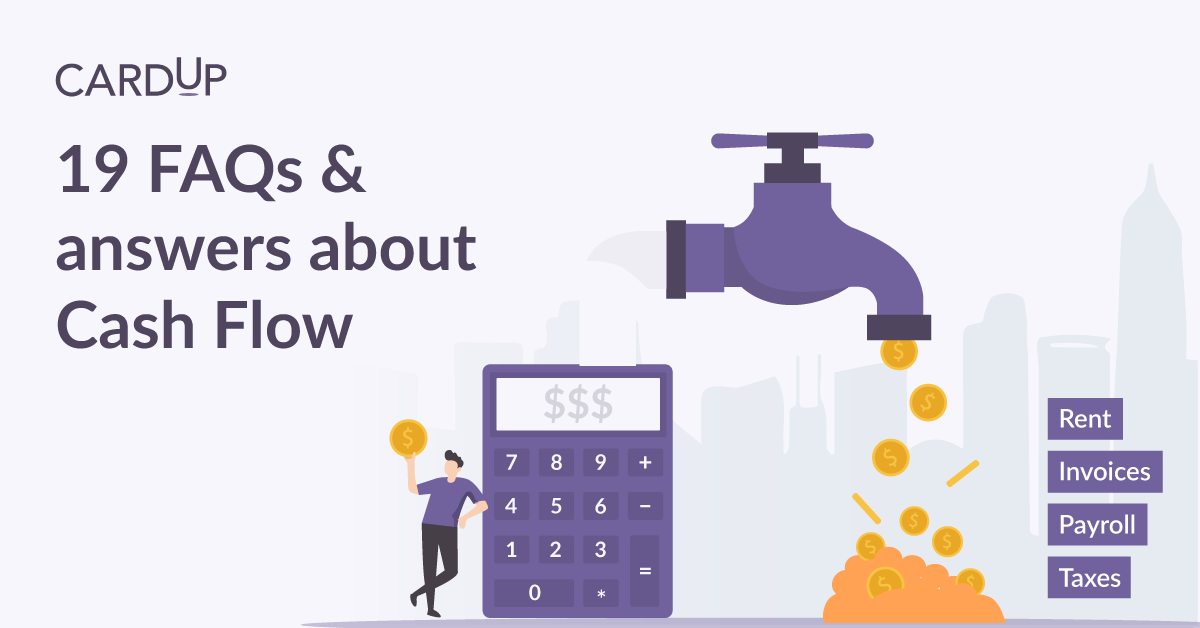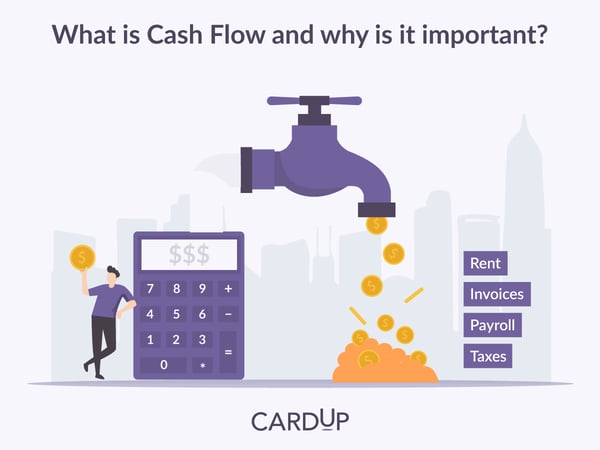19 Frequently-Asked Questions (and Answers) about Cash Flow

Contents
We speak to SMEs, business owners, accounting and finance professionals on a daily basis, and have gathered many insights about cash flow and financing. In our conversations, we have realised that there are often many misconceptions around the topic of cash flow — a lack of understanding can easily lead to cash flow management issues. The topic of cash flow is indeed not an easy concept to grasp, so we've tried breaking it down.
Here’s a summary of the 19 most commonly-asked questions, and answers to them!
Cash flow guide:
- What is cash flow?
- What are some early signs of cash flow problems?
- What is the difference between net income and cash flow?
- How do I convert profit into cash flow?
- Why is cash flow important for my business?
- How many businesses fail due to cash flow problems?
- What are some good cash flow habits?
- How to increase your cash flow?
- How do I do a cash flow analysis?
- What is after-tax cash flow?
- How do I do a cash flow forecast?
- What is levered free cash flow?
- Can cash flow be negative?
- What happens when cash flow is negative?
- Can cash flow be sheltered by depreciation?
- What is free cash flow?
- How do I calculate Free Cash Flow (FCF) from a cash flow statement?
- How do I calculate operating cash flow?
- How do I know if cash flow statements are correct?

1. What is cash flow?
This is one of the most common questions around business finance. Simply stated, cash flow is the money coming in and out of your business. Most importantly, it is the cash you have on hand to pay bills and keep your business running.
2. What are some early signs of cash flow problems?
Cash flow problems do not have to catch you off guard — there are early warning signs you can watch out for. Some of them include:
- Relying on big customers paying large bills to “get you through” tough times.
- You have too many receivables and you’re not being paid steadily.
- You are not getting discounts when paying your bills.
- You have a lot of short-term debt.
- You have too much inventory and sales are down.
> Read more about the 5 warning signs of an upcoming cash flow crunch
3. What is the difference between net income and cash flow?
Net income is gross income minus expenses in an accounting period. Cash flow is determined by changes in cash balances from one accounting period to the next.
4. How do I convert profit into cash flow?
In order to understand what cash you have on hand and what is available for “cash flow,” you may need to convert actual profits to cash flow. To convert your profit to cash flow, you need a balance sheet for the period you are converting cash flow for. As a general rule the following formula works:
 5. Why is cash flow important?
5. Why is cash flow important?
The answers to all of the other questions on this list help answer this one: cash flow provides the money necessary to pay your bills, buy supplies, pay your employees, and keep your business operating.
6. How many businesses fail due to cash flow problems?
82 per cent of small businesses fail due to cash flow. There is nothing more disheartening than building a thriving business and watching it fall apart because too much money was in receivables and bills can’t be paid.
7. What are some good cash flow habits?
Becoming better at preserving cash flow is entirely possible with strong cash flow habits. First and foremost, make sure you’re running a profitable business - meaning you must sell more than you spend. Watch your debt and cut costs wherever you can. You should also negotiate the best terms possible with your vendors, liquidate obsolete assets, and build up your reserves ensuring you don’t get into a cash flow crunch.
8. How to increase your cash flow?
There are many ways to increase your cash flow, starting with speeding up the pace that your receivables come in. This may require more customer service efforts, or, giving customers an early-payment discount for paying on time. Another method could be working with a business accountant to help you assess where you can increase cash flow. The quickest method for increasing cash flow is financing or using an interest-free credit card payments platform like CardUp to give you 59 days of zero interest money.
9. How do I do a cash flow analysis?
To do a cash flow analysis you need to prepare a cash flow statement which will track how much money is coming in and out of your business. Then you can analyse your operating expenses, investments, financing costs etc. In a cash flow analysis you are examining precise details of where your business sends and earns money. You can find a handy template for that here.
10. What is after-tax cash flow?
Cash flow after taxes, often called CFAT, is calculated by adding non-cash expenses like depreciation, restructuring costs, back into net income.
11. How do I do a cash flow forecast?
Understanding your future cash flow is critical to allowing your business to function and flourish – you are predicting your future financial needs. There are five steps to forecasting cash flow:
Step 1 |
Calculate AssumptionsAs the name indicates, these are assumptions about your business, including predicting price increases, both for your suppliers and yourself. You will need sales estimates, sales cycles or seasonal changes, general cost increases, and payroll increases. |
Step 2 |
Anticipate SalesThis can be more of an art than a science, but you’ll need a handle on what to expect in sales. You can use the previous year’s sales, and look at trends to forecast your expected sales. |
Step 3 |
Expected Inflow of Cash
Determine what additional income you will have. This can include investment money, tax refunds, grants etc. |
|
Step 4 |
Expected Expenses
You will need to predict the amount you will spend over the coming period, including capital investments, cost of doing business, payroll etc. |
Step 5 |
Analyse the InformationCash flow is basically a moving, continually changing part of your business. Understanding where, when, and how the cash flows in and out of your business ensures that you will have the capital you need to function and grow. |
12. What is levered free cash flow?
Levered free cash flow is basically money that is available after all debts are paid. It is money that is not owed to anyone, and, if you have stockholders or investors, it is available to them.
13. Can cash flow be negative?
Negative cash flow occurs when you have more expenditures than income. It is often indicative of poorly managed receivables and the misunderstanding of how to use credit. Temporarily, negative cash flow is allowable, but repeated negative cash flow can cause a business to fail.
14. What happens when cash flow is negative?
When cash flow is negative, businesses can’t pay their bills or they’re forced to borrow money, pay interest, and hurt the bottom line.
15. Can cash flow be sheltered by depreciation?
Depreciation is an accounting method that spreads the expense of an asset over a period of years. It doesn’t have an immediate impact on cash flow, but, if it can absorb some of your taxable income, on paper it can have a positive impact on cash flow.
16. What is free cash flow?
Free Cash Flow (FCF) is the amount of cash a business generates after taking into account capital expenditures.
17. How do I calculate Free Cash Flow (FCF) from a cash flow statement?
You can determine FCF by taking your before-tax and interest earnings, adding depreciation and amortisation, and then subtracting changes in capital expenditures and working capital.
18. How do I calculate operating cash flow?
Operating cash flow analysis helps you understand the cash flow of the individual parts of your business. You can determine cash flow from operating activities by taking your Net Income, adding Non-cash Expenses and Changes in Working Capital.
19. How do I know if cash flow statements are correct?
In order to ensure that your cash flow statements are accurate, you’ll need to do a line by line analysis and verify that the information you input is accurate.
CardUp as a cash flow solution
A significant part of your business success is highly dependent on your cash flow management —such as how to monitor, analyse and increase it. Getting a good hang of it will get you a long way to managing and maximising your cash flow.
There are multiple ways you can free up cash for your business. You can choose to get a bank loan or invoice factoring. Alternatively, you can choose to leverage on your credit card for free and instant credit while earning rewards at the same time.
CardUp's platform allows you to shift your business payments onto your credit card, even where cards are not allowed. Find out more about how CardUp can help your business meet its cash flow needs.
